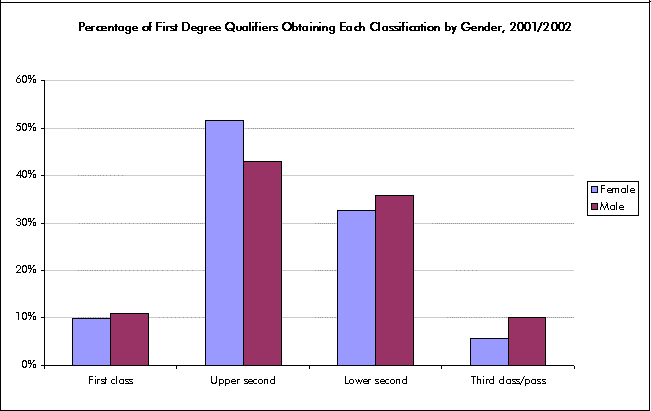Women gain more first and upper second class first degrees than men
2001/02 Higher education student data published by HESA
Analysis by the Higher Education Statistics Agency shows that when combining first class and upper second class degrees together women gain more first degrees than men. A markedly greater proportion of women obtained upper seconds than men according to the publication Students in Higher Education Institutions 2001/02 released today. This reference volume contains detailed statistical information and analysis about the student body of the UK higher education sector.
Overall, 58.2% of students of known classification who obtained a classified first degree were awarded first or upper second class honours, with 10.4% being awarded a first. More detail on the gender difference by classification of first degree is shown in the chart below:

The latest figures show that 2,086,075 higher education students were studying at publicly funded higher education institutions in the UK. Of these just over 60% were studying full-time or sandwich courses. Undergraduate students made up 77.5% of the student population.
Females make up 56.2% of the student population and outnumber their male colleagues in both full-time and part-time study.There were 242,755 overseas students that made up 11.6% of the entire student body.
The most popular subject area of study at first degree (e.g. BA/BSc etc) and other undergraduate (i.e. mostly diplomas and certificates) was business & administrative studies. A large amount of students were studying other undergraduate and part-time first degree programmes in subjects allied to medicine (which include nursing). Other subject areas which were popular at other undergraduate level were computer science, social, economic & political studies and languages.
Ethnic minorities comprised 14.1% of all first year UK domiciled students (where ethnicity was known) and were more strongly represented among full-time undergraduates and taught postgraduates. They were less strongly represented among research students, and among part-time students generally as shown in the table below:
| Ethnic Minority Students as a Percentage of UK Domiciled First Year Students of Known Ethnicity 2001/02 | ||
|---|---|---|
| Percentages | ||
| Research for a higher degree | 11.5 | |
| Full-time | 11.6 | |
| Part-time | 11.3 | |
| Taught course for a higher degree | 16.9 | |
| Full-time | 20.9 | |
| Part-time | 13.9 | |
| Other postgraduate | 9.2 | |
| Full-time | 9.7 | |
| Part-time | 8.9 | |
| First degree | 16.9 | |
| Full-time | 17.3 | |
| Part-time | 14.0 | |
| Other undergraduate | 11.6 | |
| Full-time | 19.7 | |
| Part-time | 9.5 | |
Other key points
- 3775 students are studying for the new foundation degree
- Full-time first degree students made up 45.1% of the recorded HE student population
- 61.6% of part-time first degree entrants were aged 30 or over
- Students on sandwich programmes constitute 7.8% of all undergraduates
- Overall, 68.6% of first year students were following programmes of up to three years expected duration.
Notes for editors
- The Reference Volume Students in Higher Education Institutions 2001/02 provides a statistical reference about students within Higher Education in the UK for 2001/02.
- The Reference Volume is available from the Customer Services Team, HESA Services Ltd., 95 Promenade ,Cheltenham, GL50 1HZ; telephone: 01242 255577. An electronic version on disk is also available. A list of other publications can be obtained from the Customer Services Team.
- HESA cannot accept responsibility for any inferences or conclusions derived from the data by third parties.
- Press enquiries should be directed Press Officer at HESA, 95 Promenade, Cheltenham, GL50 1HZ ; telephone 01242 211136. Other enquiries about HESA data should be addressed to the Information Services Team at the same address, telephone 01242 211133.
Ends

Press Officer
